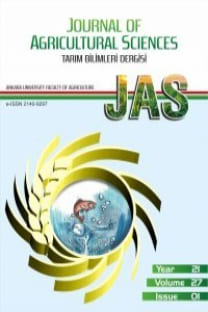Rangeland Condition and the Appropriate Rangeland Management Methods
Rangeland Condition and the Appropriate Rangeland Management Methods
___
- Antje B (2004). Range management systems in arid Namibia. What can livestock numbers tell us?. Journal of Arid Environments 59: 387-408
- Ariapour A, Mehrabi H R & Pahlavan D A (2016). Effect of rangeland plans on production, and condition Rangelands: a Case Study in Rangelands in Khazal Area of Nahavand County. Rangeland Journal 10: 1-10 (In Persian)
- Arzani H (1994). Some aspects of estimating short and long term rangeland carrying capacity in the Western Division of New South Wales. Ph.D. Thesis, University of New South Wales, Australia, 304
- Arzani H, Eftekhari A, Dehdari S, Borhani M & Kiani R (2011). Final report of the investigating the effect of rangeland plans on the condition and capacity of rangelands in the arid and semiarid climatic zones. University of Tehran, 243 (In Persian)
- Borhani M, Arzani H & Jaber Al-Ansar Z (2014). Assessment of Rangeland management methods and proposed grazing systems in Semirom. Esfahan Province. Iranian Journal of Range and Desert Research 21: 530-540
- Danckworts Y E & Madam K (1991). Dynamic of Rangelands Ecosystems. Proc. Fourth International Rangelands Congress Mont Palliser France 3: 1066-1069
- Eftekhari A (2016). Effect of the range management plan on rangeland condition: a case study in Zarandieh region, Markazi province. Iranian Journal of Range and Desert Reseach 23: 218-209
- Gillen R L & Sims P L (2006). Stocking rate and weather impacts on sand sagebrush and grasses: a 20-year record. Rangeland Ecology and Management 59: 145-152
- Hardin G (1998). Essay on sciences and society: extensions of ''The tragedy of the commons''. Science 280: 682-683 Holecheck J L (2002). Do most livestock losses to poisonous plants result from "poor" range management? Journal of Range Management 55: 270-276
- Hoshino A (2009). Comparison of vegetation changes along grazing gradients with different numbers of livestock. Journal of Arid Environment 73: 687-690
- Houston W R & Woodward R R (1966). Effects of stocking rates on range vegetation and beef cattle production in the northern Great Plains. Technical Bulletins, USA Agriculture Department 64
- Kamrani K (2004). The Effect of Economic and Social Factors on Managing Rangelands in Chaharbagh Region of Semnan Province. Master's thesis, Gorgan University of Agricultural Sciences and Natural Resources, Iran. 132 (In Persian)
- Launchbaugh J L (1967). Vegetation relationships associated with the intensity of summer grazing on a clay upland range site in Kansas. Technical Bulletins, USA 20-24
- Mazaheri M, Khaksar Astaneh H & Motalebi M (2009). Calculation of the efficiency of rangelands granted in the form of range management plans in Khorasan Razavi province, Sixth Iranian Agriculture Economics Conference. Khorasan Razavi, Iran
- Mesdaghi M (2007). Range management in Iran. Astane Ghods Razavi Press: Mashhad. 333
- Moradi E & Mofidi M (2012). Effects of grazing enclosure on vegetation in Semi- Steppe rangelands of Semirom in Esfahan: a case study in Hana. Journal of Rangeland 3: 272-282
- Parker K W & Harris R W (1958). The 3-Step Method for measuring condition ad trend of forest & Ranges: A resume of its History, Development and Use 55-69 in Techniques and Methods of Measuring Understory Vegetation. U.S.D.A. Forest Service, Southern Forest Experiment Station and Southeastern Forest Experiment Station, Tifton, Georgia.
- Qandali K (2001). Comparison of the effect of Rangeland management methods on Rangelands in Semnan Province. MSc Thesis, Emam Khomeini University, Iran, 119
- Safari H, Arzani H & Tavili A (2016). Selection of rangeland breeding methods based on environmental conditions: a case study in Middle Taleghan rangelands. Range and Watershed Management. Iranian Natural Resources Journal 69: 611-619
- Savory A (1987). A holistic approach to range management using short duration grazing. Proc. Intn'l. Rangel. Congr 1: 555-557
- Shoop M C & Mcllvain E H (1971). Why some cattlemen overgraze and some don't. Journal of Range Management 24: 252-257
- Tawafi S & Arzani H (2012). Evaluation of the sustainability of rangeland exploitation by integrating social, economic. GIS and RS indices: a case study in Chalous Road ranges in the Arengeh. Ph.D. Thesis, Islamic Azad University, Iran, 113 (In Persian)
- Teague W R & Dowhower S L (2002). Patch dynamics under rotational and continuous grazing management in large, heterogeneous paddocks. Journal of Arid Environments 53: 211-229
- Valentine J F (2001). Grazing Management. University of San Francisco: USA. 659
- Walker B (1993). Rangeland ecology: understanding and managing change. Ambio 22: 80-87
- Zare Chahuki M A (2016). Data analysis in natural resources research using SPSS Software. Jihad Daneshgahi Press: Tehran. 310
- Yayın Aralığı: 4
- Yayıncı: Ankara Üniversitesi Basımevi
Kambiz KAMRANİ, Hosein ARZANİ, Seyed Akbar JAVADİ, Reza AZİZİ NEJAD
Modeling and Design a Special Type of Passive Solar Greenhouse in Cold Climate by TRNSYS
Saleh MOHAMMADI, Amir Hosein Afkari SAYYAH, Ali Mohammad NIKBAKHT, Esmail KHALIFE
Hasan ZAMANİ, Mohammad Javad ARVİN, Abdolhossein Aboutalebi JAHROMİ, Vahid ABDOSSİ, Ali Mohammadi TORKASHVAND
Amir Hossein AFKARİ SAYYAH, Saleh MOHAMMADİ, Ali Mohammad NİKBAKHT, Esmail KHALİFE
Atilla POLAT, Bee CHİM, Sandeep KUMAR, Shannon OSBORNE
Mert YILDIZ, Burak VARIS, Ozge HORZUM, Nurdan TUNA GÜNEŞ
Zeljko DOLİJANOVİC, Svetlana ROLJEVİĆ NİKOLİĆ, Dušan KOVAČEVİĆ, Rajko MİODRAGOVİĆ, Aleksandar KOVAČEVİĆ
Physiological Responses of Gamma-Irradiated Onion Bulbs during Storage
Sahel MILADI LARI, Mehrdad AHMADI, Abdolkarim KASHI, Amir MOUSAVI, Younes MOSTOFI
